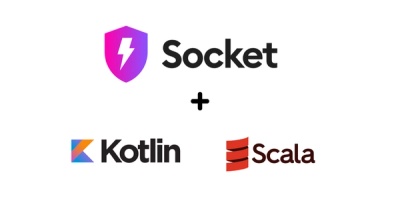
Product
Introducing Scala and Kotlin Support in Socket
Socket now supports Scala and Kotlin, bringing AI-powered threat detection to JVM projects with easy manifest generation and fast, accurate scans.
Would you like fully reproducible and reusable experiments that run on HPC clusters as seamlessly as on your machine? Do you have to comment out large parts of your pipelines whenever something failed? Tired of writing and submitting Slurm scripts? Then dawgz is made for you!
The dawgz package provides a lightweight and intuitive Python interface to declare jobs along with their dependencies, requirements, settings, etc. A single line of code is then needed to execute automatically all or part of the workflow, while complying to the dependencies. Importantly, dawgz can also hand over the execution to resource management backends like Slurm, which enables to execute the same workflow on your machine and HPC clusters.
The dawgz package is available on PyPi, which means it is installable via pip.
pip install dawgz
Alternatively, if you need the latest features, you can install it using
pip install git+https://github.com/francois-rozet/dawgz
In dawgz, a job is a Python function decorated by @dawgz.job. This decorator allows to define the job's parameters, like its name, whether it is a job array, the resources it needs, etc. The job's dependencies are declared with the @dawgz.after decorator. At last, the dawgz.schedule function takes care of scheduling the jobs and their dependencies, with a selected backend. For more information, check out the interface and the examples.
Follows a small example demonstrating how one could use dawgz to calculate π (very roughly) using the Monte Carlo method. We define two jobs: generate and estimate. The former is a job array, meaning that it is executed concurrently for all values of i = 0 up to tasks - 1. It also defines a postcondition ensuring that the file pi_{i}.npy exists after the job's completion. The job estimate has generate as dependency, meaning it should only start after generate succeeded.
import glob
import numpy as np
import os
from dawgz import job, after, ensure, schedule
samples = 10000
tasks = 5
@ensure(lambda i: os.path.exists(f"pi_{i}.npy"))
@job(array=tasks, cpus=1, ram="2GB", time="5:00")
def generate(i: int):
print(f"Task {i + 1} / {tasks}")
x = np.random.random(samples)
y = np.random.random(samples)
within_circle = x**2 + y**2 <= 1
np.save(f"pi_{i}.npy", within_circle)
@after(generate)
@job(cpus=2, ram="4GB", time="15:00")
def estimate():
files = glob.glob("pi_*.npy")
stack = np.vstack([np.load(f) for f in files])
pi_estimate = stack.mean() * 4
print(f"π ≈ {pi_estimate}")
schedule(estimate, name="pi.py", backend="async")
Running this script with the "async" backend displays
$ python examples/pi.py
Task 1 / 5
Task 2 / 5
Task 3 / 5
Task 4 / 5
Task 5 / 5
π ≈ 3.141865
Alternatively, on a Slurm HPC cluster, changing the backend to "slurm" results in the following job queue.
$ squeue -u username
JOBID PARTITION NAME USER ST TIME NODES NODELIST(REASON)
1868832 all estimate username PD 0:00 1 (Dependency)
1868831_[2-4] all generate username PD 0:00 1 (Resources)
1868831_0 all generate username R 0:01 1 node-x
1868831_1 all generate username R 0:01 1 node-y
In addition to the Python interface, dawgz provides a simple command-line interface (CLI) to list the scheduled workflows, the jobs of a workflow or the output(s) of a job.
$ dawgz
Name ID Date Backend Jobs Errors
-- ------ -------- ------------------- --------- ------ --------
0 pi.py 8094aa20 2022-02-28 16:37:58 async 2 0
1 pi.py 9cc409fd 2022-02-28 16:38:33 slurm 2 0
$ dawgz 1
Name ID State
-- ------------- ------- -------------------------
0 generate[0-4] 1868831 COMPLETED,PENDING,RUNNING
1 estimate 1868832 PENDING
$ dawgz 1 0
Name State Output
-- ----------- --------- ----------
0 generate[0] COMPLETED Task 1 / 5
1 generate[1] COMPLETED Task 2 / 5
2 generate[2] RUNNING
3 generate[3] RUNNING
4 generate[4] PENDING
The package provides four decorators:
@dawgz.job registers a function as a job, with its settings (name, array, resources, ...). It should always be the first (lowest) decorator. In the following example, a is a job with the name "A" and a time limit of one hour.
@job(name="A", time="01:00:00")
def a():
All keyword arguments other than name, array and array_throttle are passed as settings to the scheduler. For example, with the slurm backend, the following would lead to a job array of 64 tasks, with a maximum of 3 simultaneous tasks running exclusively on tesla or quadro partitions.
@job(array=64, array_throttle=3, partition="tesla,quadro")
Importantly, a job is shipped with its context, meaning that modifying global variables after it has been created does not affect its execution.
However, a job is not shipped with its dependencies. This means that updating or modifying a dependency (i.e. a module) after a job has been submitted can affect its execution. If this is an issue for you, you can register your module such that it is pickled by value rather than by reference.
import cloudpickle
import my_module
cloudpickle.register_pickle_by_value(my_module)
@job
def a():
my_module.my_function()
@dawgz.after adds one or more dependencies to a job. By default, the job waits for its dependencies to complete with success. The desired status can be set to "success" (default), "failure" or "any". In the following example, b waits for a to complete with "failure".
@after(a, status="failure")
@job
def b():
@dawgz.waitfor declares whether the job has to wait for "all" (default) or "any" of its dependencies to be satisfied before starting. In the following example, c waits for either a or b to complete (with success).
@after(a, b)
@waitfor("any")
@job
def c():
@dawgz.ensure adds a postcondition to a job, i.e. a condition that must be True after the execution of the job. Not satisfying all postconditions after execution results in an AssertionError at runtime. In the following example, d ensures that the file log.txt exists.
@ensure(lambda: os.path.exists("log.txt"))
@job
def d():
Traditionally, postconditions are only necessary indicators that a task completed with success. In dawgz, they are considered both necessary and sufficient indicators. Therefore, postconditions can be used to detect jobs that have already been executed and prune them out of the workflow. To do so, set prune=True in dawgz.schedule.
Currently, dawgz.schedule supports three backends: async, dummy and slurm.
async waits asynchronously for dependencies to complete before executing each job. The jobs are executed by the current Python interpreter.dummy is equivalent to async, but instead of executing the jobs, prints their name before and after a short (random) sleep time. The main use of dummy is debugging.slurm submits the jobs to the Slurm workload manager by automatically generating sbatch submission scripts.FAQs
Directed Acyclic Workflow Graph Scheduling
We found that dawgz demonstrated a healthy version release cadence and project activity because the last version was released less than a year ago. It has 1 open source maintainer collaborating on the project.
Did you know?

Socket for GitHub automatically highlights issues in each pull request and monitors the health of all your open source dependencies. Discover the contents of your packages and block harmful activity before you install or update your dependencies.

Product
Socket now supports Scala and Kotlin, bringing AI-powered threat detection to JVM projects with easy manifest generation and fast, accurate scans.

Application Security
/Security News
Socket CEO Feross Aboukhadijeh and a16z partner Joel de la Garza discuss vibe coding, AI-driven software development, and how the rise of LLMs, despite their risks, still points toward a more secure and innovative future.

Research
/Security News
Threat actors hijacked Toptal’s GitHub org, publishing npm packages with malicious payloads that steal tokens and attempt to wipe victim systems.